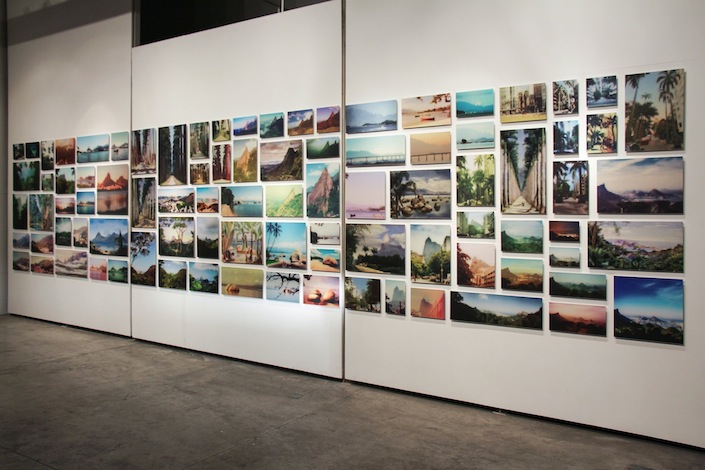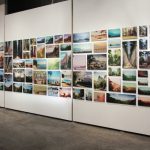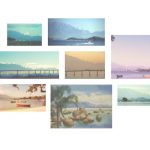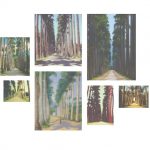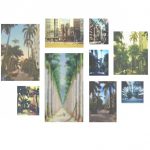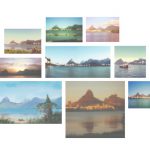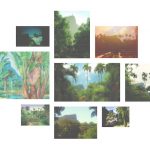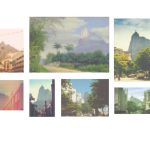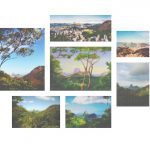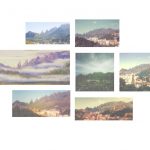Galeria Leme presents Felipe Cama’s third solo exhibition in the gallery. In “Sul X North” the artist deepens his interest in the digital image, continuing his examination of its ambiguous status as a matrix of visual experience as well as its modes of diffusion, circulation, reproduction and consumption.
In this new series, the computer-internet binomial remains the central axis of the work, both from an instrumental point of view and also as a source of raw material for the work. The exhibition is not only about the possibilities and limitations of the nature of digital and electronic media, but also questions the problem of representation of images from art history through these same channels.
To better articulate this parallel between two forms of image production and presentation, Felipe Cama focuses, on the one hand, on the work of travelling artist Marianne North (1830-1890), and on the other, the artist appropriates several photos from anonymous tourists, posted on the internet.
North, an English naturalist and botanist, was a pioneer woman for her time. A travelling artist, she began her excursions in 1871, first going to Canada, United States and Jamaica, and finally living in Brazil for a year, where she worked in a cabin inside the forest. The artist made numerous paintings depicting the landscape of nineteenth century Rio de Janeiro, carefully representing the vegetation and the landscape, which gradually underwent changes made by the human settlements.
Despite the alterations of the landscape, over more than two centuries, the artist was so accurate in her choice of images, that today we can very often find the same angles on the photos of many tourists who passed by Rio de Janeiro.
Though they have completely different ontologies, both ways of recording reality, when encountered on the Internet, are presented as digital files, quickly circulated on the network and available for consumption. Even unique works, such as paintings, end up being stripped of their materiality to move through the system in the form of digitalized images. So, they are not distinguishable from the prosaic photos taken today, and are also consumed as a substitute for the genuine experience of being in front of a canvas or admiring a beautiful landscape.
After appropriating these images, the artist does not adulterate the “original”. However, he overlaps them with a geometric mesh that accentuates the simulated effect of synthesized images. Homogenizing them as pixels (forming particles of the digital image).
The exhibition features a group of 11 polyptychs, which make up a set of about 90 images in total. Through this excess, the artist intends to represent the implications of the great quantity of information that we handle after the arrival of the internet, while making a parallel with the way Marianne North’s works are permanently displayed in her gallery in Kew Gardens, Great Britain, which fill the entire walls of the space.
About the artist:
Felipe Cama, Porto Alegre, Brazil, 1970. Lives and works in São Paulo, Brazil.
Graduated in Communication from the School of Communications and Arts at USP, São Paulo, and extension in Fine Arts at FAAP, São Paulo, Brazil.
Solo Shows: Autorretratos Estatísticos, Galeria Leme, São Paulo, Brazil, 2012; After Post – Fundação Joaquim Nabuco, Recife, Brazil, 2010; Exhibitions program 2007, Centro Cultural São Paulo, São Paulo, Brazil, 2007, among others.
Group shows: “Ichariba Chode” Brazilian Contemporary Art, Plaza North Gallery, Saitama, Japan; O Espírito de Cada Época, Instituto Figueiredo Ferraz, Ribeirão Preto, Brazil; Retroprospectiva: 25 anos do Programa de Exposições CCSP, Centro Cultural São Paulo, Brazil (2015); Entre Dois Mundos – Museu Afro Brasil, São Paulo, Brazil; 140 Caracteres – MAM, São Paulo, Brazil (2014); O Artista como Autor/O Artista como Editor, MAC/USP, São Paulo, Brazil (2013), among others.
In 2010 he was awarded at the Projeto Trajetórias of Joaquim Nabuco Foundation, Recife. In 2007 at the Exhibition Program of the Centro Cultural São Paulo (Acquisitive Award), among others.
His work is included in collections such as; MAC USP – Museum of Contemporary Art of São Paulo; MAM SP – São Paulo Museum of Modern Art; Coleção de Arte da Cidade – Centro Cultural São Paulo; IFF – Institute Figueiredo Ferraz, Ribeirão Preto, among others.
